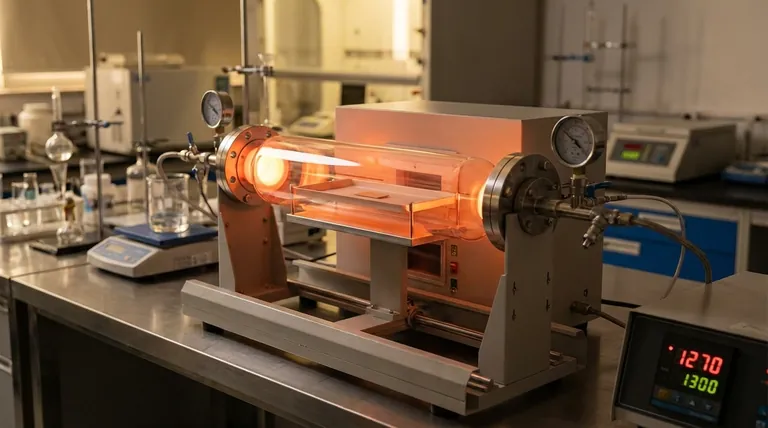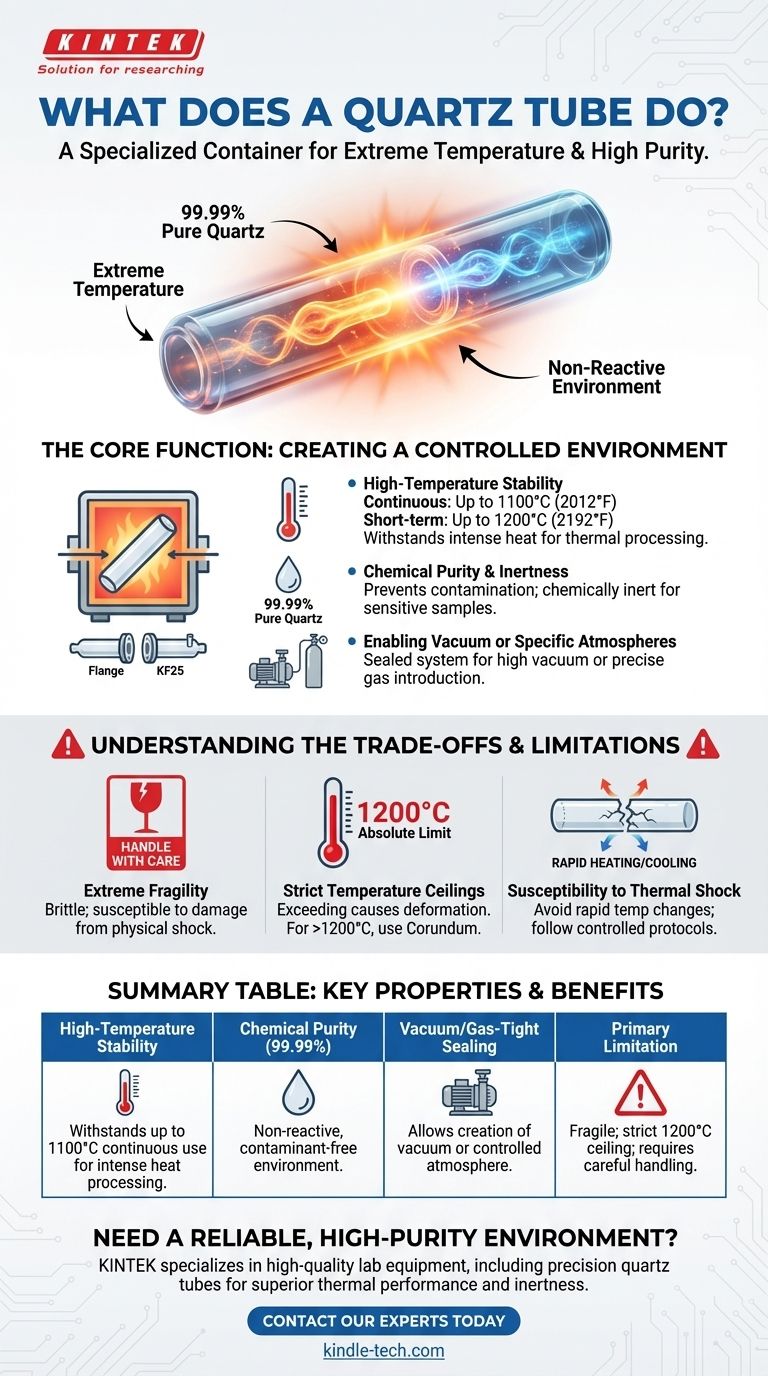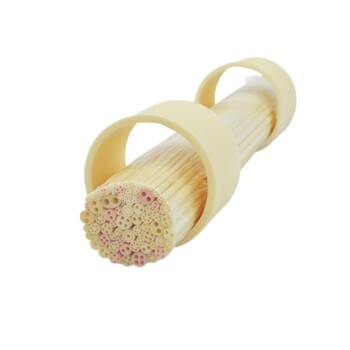At its core, a quartz tube serves as a specialized container designed to operate under conditions of extreme temperature and high purity. It is engineered from 99.99% pure quartz, allowing it to house materials or processes that require a pristine, non-reactive, and thermally stable environment, most commonly within a tube furnace.
A quartz tube is not merely a piece of glassware; it is a critical component that creates a precisely controlled and isolated environment, enabling high-temperature chemical reactions, material synthesis, and thermal processing that would otherwise be impossible.

The Core Function: Creating a Controlled Environment
A quartz tube's primary role is to isolate a sample or process from the outside world. This isolation is achieved through a combination of material properties and system design.
High-Temperature Stability
A key function of the quartz tube is to withstand intense heat. It is reliably rated for continuous use at temperatures up to 1100°C (2012°F).
For brief periods, it can handle short-term exposure up to 1200°C (2192°F). Pushing beyond this limit risks permanent deformation and failure of the tube.
Chemical Purity and Inertness
The tube is made from 99.99% pure quartz, which is chemically inert. This extreme purity is critical because it prevents the tube itself from reacting with or contaminating the samples inside, ensuring the integrity of the experiment or process.
Enabling Vacuum or Specific Atmospheres
Quartz tubes are typically integrated into a larger assembly with flanges and valves. These fittings, often made of stainless steel, allow the tube to be sealed.
This seal enables operators to either pump out the air to create a high vacuum or to introduce specific gases, creating a precisely controlled atmosphere for the process inside. Interfaces like a KF25 port are standard for connecting to a vacuum pump system.
Understanding the Trade-offs and Limitations
While powerful, quartz is not without its challenges. Understanding its limitations is crucial for successful and safe operation.
Extreme Fragility
The primary trade-off for quartz's thermal performance and purity is its fragility. The material is brittle and highly susceptible to damage from physical shock.
It must be handled gently at all times, avoiding collisions, drops, or even strong vibrations, which can cause microscopic fractures that lead to failure under heat and pressure.
Strict Temperature Ceilings
The 1200°C short-term temperature limit is an absolute ceiling. Exceeding it will cause the quartz to soften and deform, compromising the structural integrity of the entire system.
For applications requiring temperatures above this limit, an alternative material such as a corundum tube must be used.
Susceptibility to Thermal Shock
Rapid changes in temperature can create internal stresses that will crack the tube. Both heating and cooling rates must be carefully controlled to prevent this thermal shock. Never place a hot tube on a cold surface or introduce a cold item into a hot tube.
Making the Right Choice for Your Application
Proper use of a quartz tube hinges on respecting its properties. Your operational goal will dictate how you approach its use.
- If your primary focus is high-purity processing below 1100°C: A quartz tube is the ideal and standard choice for creating a clean, controlled, and thermally stable environment.
- If your primary focus is working with temperatures above 1200°C: You must use an alternative material, as a quartz tube is not suitable and will fail.
- If your primary focus is operational safety and longevity: Prioritize careful handling and strict adherence to gradual heating and cooling protocols to avoid both physical breakage and thermal shock.
Understanding these capabilities and limitations is the key to leveraging a quartz tube for reliable and repeatable results.
Summary Table:
| Key Property | Function & Benefit |
|---|---|
| High-Temperature Stability | Withstands continuous use up to 1100°C, enabling intense heat processing. |
| Chemical Purity (99.99%) | Provides a non-reactive, contaminant-free environment for sensitive materials. |
| Vacuum/Gas-Tight Sealing | Allows creation of a vacuum or controlled atmosphere for precise reactions. |
| Primary Limitation | Fragile; requires careful handling and has a strict 1200°C temperature ceiling. |
Need a reliable, high-purity environment for your lab processes?
A quartz tube is essential for high-temperature applications where contamination cannot be tolerated. At KINTEK, we specialize in providing high-quality lab equipment and consumables, including precision quartz tubes designed for superior thermal performance and chemical inertness.
Let us help you achieve precise and repeatable results. Contact our experts today to find the perfect quartz tube solution for your specific laboratory needs.
Visual Guide

Related Products
- Laboratory Quartz Tube Furnace Tubular RTP Heating Furnace
- 1400℃ Laboratory Quartz Tube Furnace with Alumina Tube Tubular Furnace
- 1700℃ Laboratory Quartz Tube Furnace with Alumina Tube Tubular Furnace
- Vertical Laboratory Quartz Tube Furnace Tubular Furnace
- High Pressure Laboratory Vacuum Tube Furnace Quartz Tubular Furnace
People Also Ask
- What is quartz tube heating? Achieve Instant, Targeted Heat with Infrared Radiation
- What is the temperature of a quartz tube furnace? Master the Limits for Safe, High-Temp Operation
- What is the maximum temperature for a quartz tube furnace? Key Limits for Safe & Efficient Operation
- What is the operating temperature of a quartz tube? Maximize Tube Life & Process Efficiency
- How do you clean a quartz tube furnace? Prevent Contamination & Extend Tube Lifespan



















